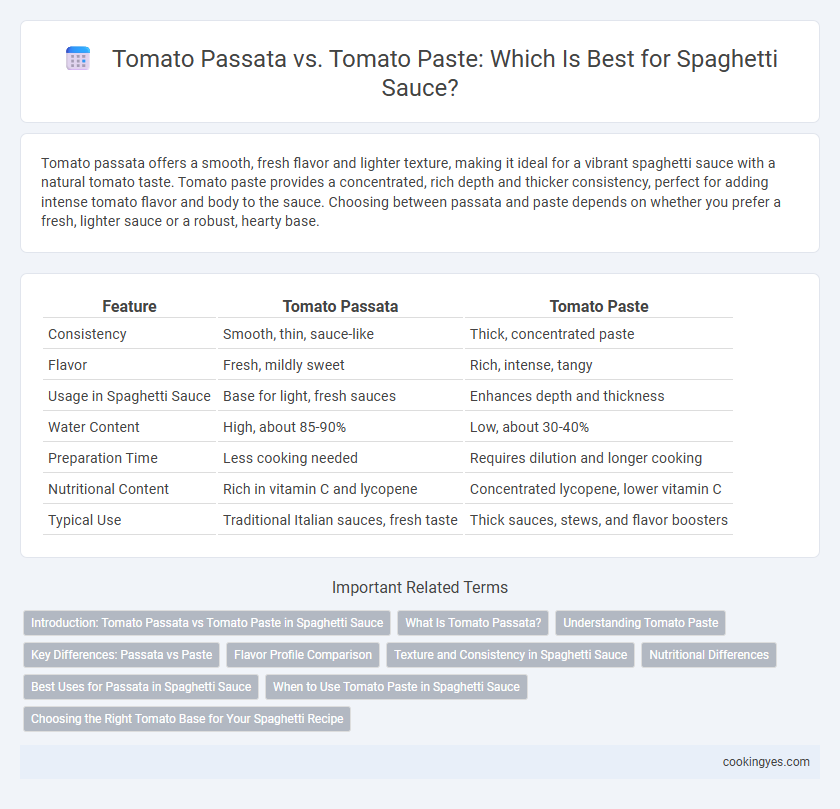Tomato passata offers a smooth, fresh flavor and lighter texture, making it ideal for a vibrant spaghetti sauce with a natural tomato taste. Tomato paste provides a concentrated, rich depth and thicker consistency, perfect for adding intense tomato flavor and body to the sauce. Choosing between passata and paste depends on whether you prefer a fresh, lighter sauce or a robust, hearty base.
Table of Comparison
| Feature | Tomato Passata | Tomato Paste |
|---|---|---|
| Consistency | Smooth, thin, sauce-like | Thick, concentrated paste |
| Flavor | Fresh, mildly sweet | Rich, intense, tangy |
| Usage in Spaghetti Sauce | Base for light, fresh sauces | Enhances depth and thickness |
| Water Content | High, about 85-90% | Low, about 30-40% |
| Preparation Time | Less cooking needed | Requires dilution and longer cooking |
| Nutritional Content | Rich in vitamin C and lycopene | Concentrated lycopene, lower vitamin C |
| Typical Use | Traditional Italian sauces, fresh taste | Thick sauces, stews, and flavor boosters |
Introduction: Tomato Passata vs Tomato Paste in Spaghetti Sauce
Tomato passata offers a smooth, fresh flavor and lighter texture ideal for authentic spaghetti sauce, while tomato paste provides a concentrated, intense tomato taste that thickens the sauce quickly. Passata is made from pureed ripe tomatoes strained to remove seeds and skin, ensuring a bright, natural tomato essence. Tomato paste, cooked down to reduce moisture, delivers depth and richness, making it a robust base in spaghetti sauces requiring longer simmering.
What Is Tomato Passata?
Tomato passata is a smooth, strained tomato puree made from fresh, ripe tomatoes, offering a sweet and fresh flavor ideal for spaghetti sauce. It differs from tomato paste by its thinner consistency and lack of cooking, retaining the natural taste of tomatoes. Using passata in spaghetti sauce provides a vibrant base that enhances the sauce's texture and freshness without the concentrated intensity of tomato paste.
Understanding Tomato Paste
Tomato paste is a concentrated product made by cooking tomatoes for several hours to reduce moisture, then straining and cooking the puree again to achieve a thick consistency ideal for enhancing spaghetti sauce flavor. It provides a rich umami base and deep tomato taste, which intensifies during simmering, unlike tomato passata that offers a fresher, thinner texture. Using tomato paste in spaghetti sauce ensures a robust, well-rounded flavor profile that complements herbs and spices commonly used in traditional Italian recipes.
Key Differences: Passata vs Paste
Tomato passata is a smooth, uncooked puree made from fresh tomatoes, offering a light, natural flavor and a thinner consistency ideal for quickly cooked spaghetti sauces. Tomato paste is a concentrated product, cooked down to intensify flavor and thicken sauces, making it perfect for recipes needing a richer, bold tomato taste with a thicker texture. Using passata provides a fresher, less intense tomato flavor, while tomato paste delivers depth and thickness essential for hearty, slow-simmered spaghetti sauces.
Flavor Profile Comparison
Tomato passata offers a fresh, vibrant flavor with a smooth texture, ideal for creating light and fragrant spaghetti sauces that highlight the natural sweetness of tomatoes. Tomato paste delivers a concentrated, rich, and intense tomato flavor, providing depth and a robust umami quality that enhances hearty, slow-cooked spaghetti sauces. Choosing between passata and paste depends on the desired sauce complexity, with passata favoring brightness and freshness, while paste intensifies and thickens the sauce with bold tomato essence.
Texture and Consistency in Spaghetti Sauce
Tomato passata provides a smooth, velvety texture that creates a lighter, more fluid spaghetti sauce, making it ideal for those who prefer a fresh, natural tomato taste. Tomato paste, being highly concentrated, thickens the sauce significantly and offers a dense, rich consistency that clings well to pasta strands. Choosing between passata and paste depends on whether a silky or robust texture is desired in the final spaghetti sauce.
Nutritional Differences
Tomato passata contains higher water content and offers more vitamin C and antioxidants, making it a lighter option for spaghetti sauce. Tomato paste is nutrient-dense with concentrated lycopene, providing more iron and potassium per serving but also higher calories. Choosing between passata and paste depends on desired sauce thickness and nutritional emphasis on vitamins versus mineral concentration.
Best Uses for Passata in Spaghetti Sauce
Tomato passata offers a smoother, fresher base for spaghetti sauce, making it ideal for recipes requiring a light, bright tomato flavor without the thickness of paste. Its naturally thin consistency allows it to blend seamlessly with spices and herbs, creating a vibrant, homemade sauce perfect for quick-cooking dishes. Passata's purity retains more of the tomatoes' natural sweetness and acidity, enhancing the overall taste profile of classic Italian spaghetti sauces.
When to Use Tomato Paste in Spaghetti Sauce
Tomato paste is ideal for spaghetti sauce when a rich, concentrated tomato flavor and thick texture are desired, especially in slow-simmered recipes. Its intense umami enhances the sauce's depth, making it a key ingredient for hearty meat sauces or when fresh tomatoes are not available. Use tomato paste to create a robust base before adding other ingredients, ensuring a balanced and flavorful spaghetti sauce.
Choosing the Right Tomato Base for Your Spaghetti Recipe
Tomato passata offers a smooth, fresh tomato flavor with a thinner consistency ideal for light spaghetti sauces, while tomato paste provides a concentrated, rich taste perfect for thickening and intensifying robust sauces. Selecting tomato passata enhances brightness and freshness, making it suitable for quick-cooked recipes, whereas tomato paste delivers depth and umami, essential for slow-simmered sauces. Understanding the desired sauce texture and flavor intensity helps in choosing the optimal tomato base for authentic spaghetti dishes.
Tomato passata vs tomato paste for spaghetti sauce Infographic

 cookingyes.com
cookingyes.com